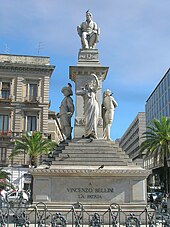
Back Catania ALS Catania AN قطانية Arabic كاتانيا ARZ Catania AST Catania AVK Catania Aymara Kataniya Azerbaijani کاتانیا AZB Катанія Byelorussian
Catania | |
|---|---|
| Comune di Catania | |
Skyline of the city with Mount Etna in the background | |
| Coordinates: 37°30′0″N 15°5′25″E / 37.50000°N 15.09028°E | |
| Country | Italy |
| Region | Sicily |
| Metropolitan city | Catania (CT) |
| Frazioni | Bicocca, Codavolpe, Junghetto, Pantano d'Arci, Paradiso degli Aranci, Passo Cavaliere, Passo del Fico, Passo Martino, Primosole, Reitano, Vaccarizzo, Villaggio Delfino |
| Government | |
| • Mayor | Enrico Trantino (Brothers of Italy) |
| Area | |
• Total | 182.90 km2 (70.62 sq mi) |
| Elevation | 7 m (23 ft) |
| Population (1 January 2019)[2] | |
• Total | 311,584 |
| • Density | 1,700/km2 (4,400/sq mi) |
| Demonym | Catanese |
| Time zone | UTC+1 (CET) |
| • Summer (DST) | UTC+2 (CEST) |
| Postal code | 95100 |
| Dialing code | 095 |
| ISTAT code | 087015 |
| Patron saint | St. Agatha |
| Saint day | 5 February |
| Website | Official website |
| Part of | Late Baroque Towns of the Val di Noto (South-Eastern Sicily) |
| Criteria | Cultural: (i)(ii)(iv)(v) |
| Reference | 1024rev-002 |
| Inscription | 2002 (26th Session) |
| Area | 38.5 ha (4,140,000 sq ft) |
| Buffer zone | 80.13 ha (8,625,000 sq ft) |



Catania (/kəˈtɑːniə/,[3] also UK: /-ˈteɪn-/, US: /-ˈtæn-/;[4][5][6] Sicilian and Italian: [kaˈtaːnja] ⓘ) is the second-largest municipality in Sicily, after Palermo, both by area and by population.[7] Despite its reputation as the second city of the island, Catania is the largest Sicilian conurbation,[citation needed] and among the largest in Italy. It has important road and rail transport infrastructures, and hosts the main airport in Sicily (fifth-largest in Italy). The city is located on Sicily's east coast, facing the Ionian Sea at the base of the active volcano Mount Etna. It is the capital of the 58-municipality region known as the Metropolitan City of Catania, which is the seventh-largest metropolitan area in Italy. The population of the city proper is 311,584,[2] while the population of the Metropolitan City of Catania is 1,107,702.[2]
Catania was founded in the 8th century BC by Chalcidian Greeks in Magna Graecia.[8] The city has weathered multiple geologic catastrophes: it was almost completely destroyed by a catastrophic earthquake in 1169.[8] A major eruption and lava flow from nearby Mount Etna nearly swamped the city in 1669 and it suffered severe devastation from the 1693 Sicily earthquake.[8]
During the 14th century, and into the Renaissance period, Catania was one of Italy's most important cultural, artistic and political centres.[8] It was the site of Sicily's first university, founded in 1434.[8] It has been the native or adopted home of some of Italy's most famous artists and writers, including the composers Vincenzo Bellini and Giovanni Pacini, and the writers Giovanni Verga, Luigi Capuana, Federico De Roberto and Nino Martoglio.
Catania today is the industrial, logistical, and commercial centre of Sicily. Its airport, the Catania–Fontanarossa Airport, is the largest in Southern Italy. The central "old town" of Catania features exuberant late-baroque architecture, prompted after the 1693 earthquake, and is a UNESCO World Heritage Site.
- ^ "Superficie di Comuni Province e Regioni italiane al 9 ottobre 2011". Italian National Institute of Statistics. Retrieved 16 March 2019.
- ^ a b c Official ISTAT figures [1] Archived 3 May 2020 at the Wayback Machine
- ^ Jones, Daniel (2011). Roach, Peter; Setter, Jane; Esling, John (eds.). "Catania". Cambridge English Pronouncing Dictionary (18th ed.). Cambridge University Press. p. 79. ISBN 978-0-521-15255-6.
- ^ "Catania" (US) and "Catania". Lexico UK English Dictionary. Oxford University Press. Archived from the original on 22 March 2020.
- ^ "Catania". Merriam-Webster.com Dictionary. Merriam-Webster. Retrieved 8 January 2019.
- ^ "Catania". Collins English Dictionary. HarperCollins. Retrieved 26 July 2019.
- ^ "Sicilia / Sicily (Italy): Provinces, Major Cities & Communes - Population Statistics, Maps, Charts, Weather and Web Information". www.citypopulation.de. Retrieved 2 June 2023.
- ^ a b c d e "Catania history – Catania culture – Catania – attractions in Catania – art Catania – history guide Catania – Italy Katane". Travelplan.it. Retrieved 1 June 2010.












